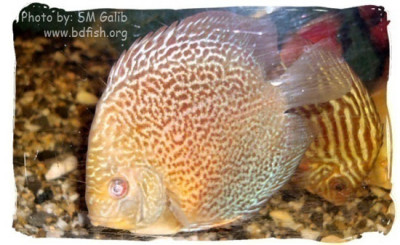Crystal Clear Nano: 7 Steps To Control Algae In Your Nano Aquarium – What really works.
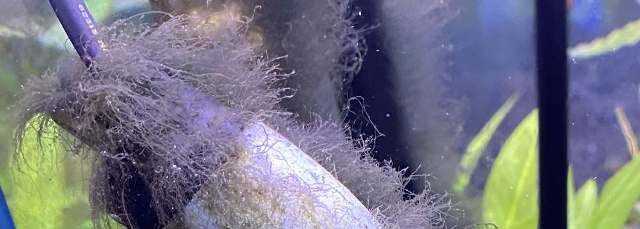
Black hair algae in the authors 75 gallon aquarium
Here are the six steps to control algae in your nano aquarium:
1. Remove the algae manually / by hand.
2. Do a water change to remove the green algae-filled water and to remove the nutrients that are feeding the algae.
3. Add fish, snails, or shrimp that eat algae.
4. Remove algae from the sides of the aquarium by scrubbing the glass.
5. Do a hydrogen peroxide spray or a bleach dip on the plant or plants that have algae growing on them.
6. Reduce the amount of light that the algae is receiving.
Article: 8 Secrets to Stunning Underwater Photo Shots
What is algae? Why do you have algae?
Algae is the common name for a large variety of plants that grow in freshwater or saltwater. Algae will grow out of water if the environment is damp enough.
Algae can be simple or complex. For example, simple algae would be the algae that creates the green water in your planted aquarium. Complex algae includes seaweed and kelp that can grow up to 50 meters.
Algae has been around for a long, long time. Fossils of algae have been found that date back to 1.65 billion years ago. Obviously, it has learned to adapt and survive.
Algae is a tough plant with a huge history behind it. It wouldn’t still be around if it wasn’t good at growing easily in nearly every wet or damp environment. You have your work cut out for you controlling algae in your aquarium.
Luckily, there are several steps you can take to reduce algae growth in your tank. You’ll notice I said reduce, not eliminate. Algae cells are always present in all aquariums. Our job as aquarists is to keep them under control as best
How To Care For, Feed, And Make A Sandwich Out Of Your Adorable Goldfish
1. Manually remove hair algae from your aquarium
Hair algae is algae that attaches itself to aquarium plants and other tank items. The algae then produces long, thin threads of algae material that move with the water current.
If the clumps of hair algae are large enough, you can use your hand to pull them off.
I have also used thin plastic aquarium tubing. I push the tube into the hair algae and then spin the tube like spaghetti on a fork. A firm pull and a big clump of hair algae will usually come loose and can then be removed. I have heard pipe cleaners also work well.
2. Control algae through water changes
⇒ Large frequent water changes cure the disease (lowers the nitrate levels that cause the algae).
Everything else on this page treats the symptom (the algae).
Because your aquarium has fish and plants in it, there will always be a source of nutrients for algae to use. These nutrients are part of the nitrogen cycle.
The cycle starts with fish food, fish waste, and plant deterioration. Beneficial bacteria cause these items to decay in your nano or small aquarium. This decay releases ammonia (found as ammonium) as part of the decay process. Ammonia is a source of nutrients for plants, including algae. Bacteria change ammonia into nitrite. The beneficial bacteria change nitrites into nitrates, which is a common commercially available plant fertilizer.
If you look at any package of plant fertilizer and you’ll see nitrate (nitrogen) listed as one of the principal ingredients.
How do you control the amount of nitrate in your aquarium?
Water changes can reduce the amount of nitrates in your aquarium. Reduce the fertilizer that the algae uses to grow and you reduce the amount of algae that can grow in your aquarium.
Here is a video where I did about 20% water changes daily on my 30 gallon aquarium and the end result.
I am doing this on a 50% daily water change on a 75 gallon, algae filled, neglected aquarium. Even after only two weeks I am seeing strong positive results. I will post that video when I am satisfied with the results.
3. Add algae eating animals to your aquarium
There are certain types of fish, shrimp and snails that eat algae. Adding any or a mix of the following animals will make your job of algae control much easier.
1. Freshwater Shrimp – Shrimp are a favorable animal to add to a small planted tank. For example, Amano Shrimp. Takashi Amano began adding this freshwater shrimp species to his tanks in the 1990s. The scientific name is Caridina Multidentata. These colorful, active and interesting shrimp eat algae and also clean the gravel in the tank they are in. There are other shrimp you can use besides Amano Shrimp to take care of the algae.
2. Sucker mouth fish – These hardworking fish will remove the algae on just about any surface in your tank. These include Chinese algae eaters and bristlenose plecos. These fish can’t live on algae alone, so make sure and feed them sinking type fish food. Live bearing fish, like Mollies, also eat algae, but because of how they reproduce, over time your tank can become filled with these fish.
3. Freshwater Snails – Add freshwater snails to your aquarium to eat the algae. These include Malaysian Trumpet Snails, Ramshorn Snails, Nerite Snails and Rabbit Snails. My preference is Ramshorn snails.
The Ultimate Guide to Bristlenose Plecostomus Fish: Care, Breeding, and More!
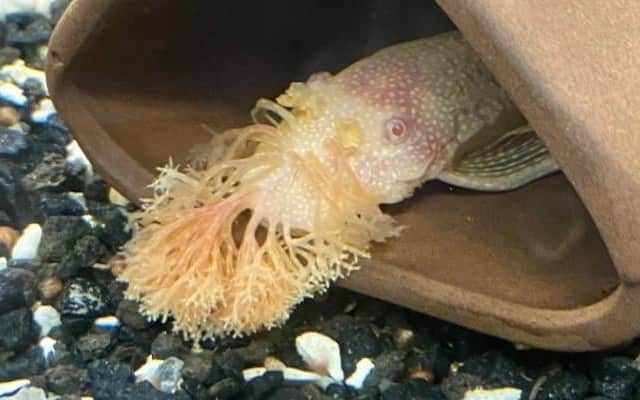
These bizarre looking fish look like they came from another, alien world. Don’t believe me? Check out the picture above.
4. Remove algae stuck to the glass, by hand.
This means scrubbing the inside of the aquarium glass with a scrub pad or a magnet scraper. The picture of my 30 gallon tank below shows a magnetic algae scraper and, just above the fish blur, is one of my algae eating snails.
5. Use hydrogen peroxide to kill the algae in your planted nano tank
Hydrogen peroxide (H2O2) can kill algae. Using hydrogen peroxide on the algae in your aquarium will cause it to turn white or pink and die within 24 hours. It won’t hurt your regular aquarium plants or aquarium pets. Don’t spray hydrogen peroxide near shrimp as I have read about shrimp dying when they were sprayed. This could happen even if someone sprayed them indirectly.
Buying hydrogen peroxide at the store in the US is usually a 3% solution (3% hydrogen peroxide and 97% water). This solution won’t need to be diluted. If the solution of hydrogen peroxide you have is a stronger solution than that, you will want to dilute the solution to between 3 and 8%.
You can use hydrogen peroxide right in your aquarium. What this means is that you can spray the H2O2 directly onto the algae. To do that, turn off anything that is moving water about in your tank (filter, powerhead etc). Then, using a syringe, gently and lightly spray the algae. After you’ve sprayed the algae with hydrogen peroxide, it will give off bubbles. Continue to do this until you have coated all the algae, except the algae on the glass, which you will scrub off manually.
When the H2O2 stops bubbling, you’ll do a major water change of at least 50%. If it were my tank, I would do an 80 to 90% water change. The H2O2 can harm beneficial bacteria, and this is the reason to do such a large water change.
6. Use bleach to kill algae
Bleach can kill algae on individual plants or leaves. This is a last resort method to be used only in extreme cases where the plant would die anyway because it is so highly covered in algae.
To use this method, you will mix one part bleach to 9 parts of water. Place this solution in a large bowl that you can get your plant into.
Pull the affected plant out of the tank, roots and all. Now, since you have easy access to the plant, gently remove any algae that you can with your fingers. You might remove all the algae this way. If not, proceed to the next step.
Dip the leaves covered with the algae into the bleach solution. Don’t put the roots into the solution. Soak the leaves the leaves for 30 seconds to a minute. This may be enough to kill all the algae.
Next, place the plant leaves in a bowl of clean warm water. Gently rub the leaves and stems in the water to remove the slippery bleach feeling. Then, in another bowl of clean water, you will add a hefty dose of aquarium water conditioner that says it will neutralize chlorine. Swish the leaves around in this solution for a minute or three.
Now place the plant back in the tank, but don’t plant it. The next day check to see if the algae is dead (it will turn white or pink). If the algae is dead, you can remove most of it by rubbing the leaves with your fingers. Then plant the plant.
If the algae isn’t dead, you will want to repeat the dipping process with a longer soak in the bleach solution.
Do you want to grow Amazon Sword plants like the ones below that I grew?
Tap this box to buy them (and other aquarium plants) on Amazon.
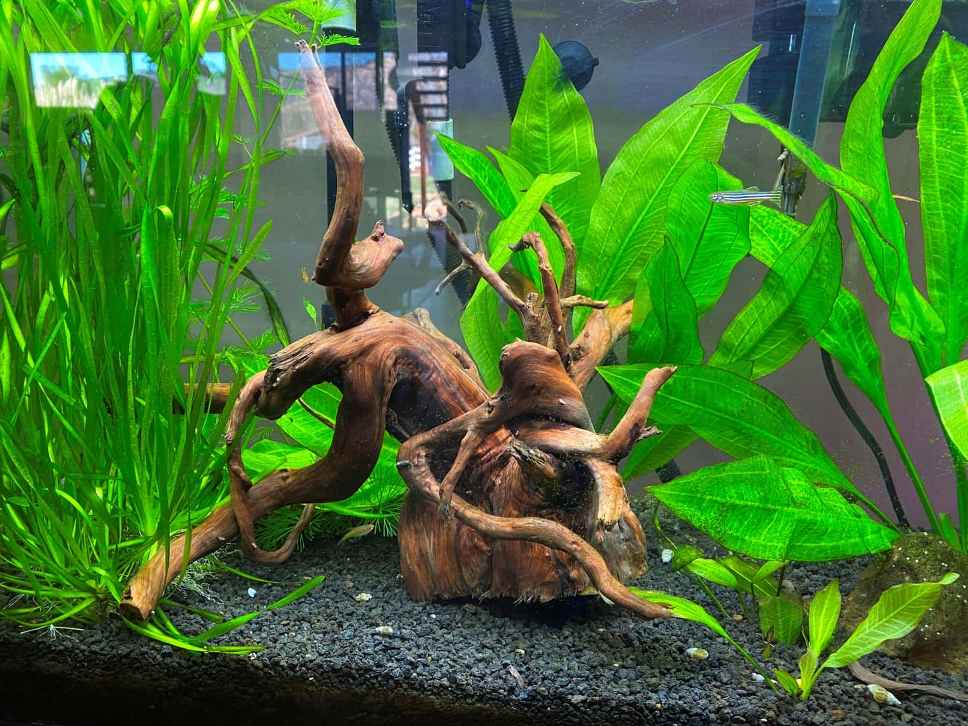
Or maybe you want to grow a giant sword plant like this one that I grew:
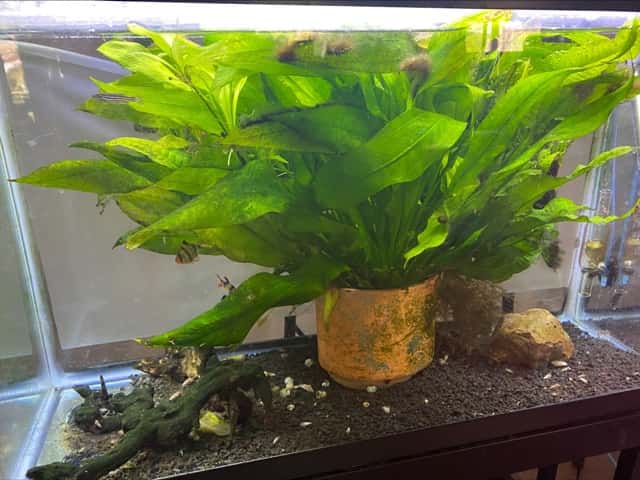
It all starts by buying the best ones. Tap this box to explore prices.
7. Reduce the amount of light your planted nano aquarium is receiving.
The amount of light an aquarium receives will influence the growth of the algae and the growth of the plants. Experiment with what works for you.
I have seen recommendations for only having your lights on for 5 hours a day (which is what I do). I have also seen 10 hours recommended.
Another way to control the amount of light the plants and algae are receiving is to decrease the lighting by raising the lights.
If you have LED lighting, you could cover a few of the bulbs with tape or paper to reduce the light.
Experiment in order to reach a balance that works best for your plants and worst for the algae.
_______________________________
Related questions about algae control
Question: My algae is still out of control. Are there any other methods I can try to fix this issue?
Answer: I can think of two other solutions that you can try that I haven’t experimented with. 1. Use a phosphate remover. Apparently, excess phosphate can cause algae bloom. 2. There are several chemicals on the market which claim to kill algae. I haven’t tried any of these, but if you’re at wits’ end, then try them and see what happens. Let me know how it works for you. (my email is realestateprofit@gmail.com)
Question: How do I know what type of algae I have in my nano aquarium?
Answer: This page has a good amount of information about algae types: https://fishtankadvisor.com/freshwater-algae-identification-treatment-prevention/
Question: Is it safe to treat the algae in my tank chemically without having to remove my Marimo moss balls?
Answer: You must remove Marimo moss balls before treating the algae in your tank with any chemicals. Set the balls into a container filled with aquarium water until you’ve finished your next large water change. It will then be safe to place them back in your aquarium.
Additional information
Algae University (Really? A university about algae? Well, ok.)
You can turn your aquarium fish hobby into an income producing side hustle.
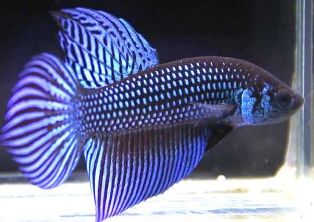
Create a website like mine to earn enough to buy aquariums, or fish, or equipment or if you work hard enough, retire from your 9 to 5.
I used "Divi" website creator to make this website. It costs $89/year (this comes out to about $7/month.)
Tap this ad to find out more.
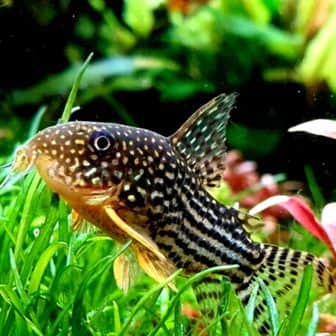
Why are the fish dying in my freshwater aquarium?
“Question: “Which freshwater aquarium fish is the hardest to kill?”
Answer: In my opinion, there are two fish that I think are hardest to kill…”
